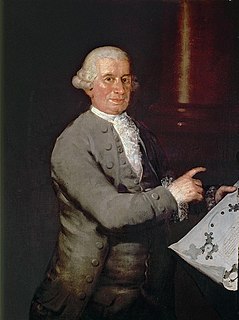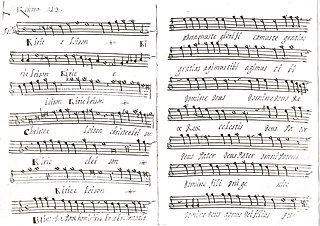Related Research Articles

Antonio de Cabezón was a Spanish Renaissance composer and organist. Blind from childhood, he quickly rose to prominence as a performer and was eventually employed by the royal family. He was among the most important composers of his time and the first major Iberian keyboard composer.
Pedro de Escobar, a.k.a. Pedro do Porto, was a Portuguese composer of the Renaissance, mostly active in Spain. He was one of the earliest and most skilled composers of polyphony in the Iberian Peninsula, whose music has survived.

Juan del Encina was a composer, poet, and playwright, often called the founder, along with Gil Vicente, of Spanish drama. His birth name was Juan de Fermoselle. He spelled his name Enzina, but this is not a significant difference; it is two spellings of the same sound, in a time when "correct spelling" as we know it barely existed.

Ventura Rodríguez Tizón was a Spanish architect and artist. Born at Ciempozuelos, Rodríguez was the son of a bricklayer. In 1727, he collaborated with his father in the work at the Royal Palace of Aranjuez.
Mateo Flecha (1481–1553) was a Catalan composer born in Kingdom of Aragon, in the region of Prades. He is sometimes known as "El Viejo" to distinguish him from his nephew, Mateo Flecha "El Joven", also a composer of madrigals. "El Viejo" is best known for his ensaladas, published in Prague in 1581 by the same nephew.
Sebastian Aguilera de Heredia was a Spanish monk, musician and composer.
Pedro Bermúdez (1558–1605) was a Spanish composer and chapel master, who has been recognised as one of the most outstanding polyphonists in the New World, and who was active in Granada, Antequera, Cusco, Santiago de Guatemala, and Puebla.
Tomás de Torrejón y Velasco Sánchez was a Spanish composer, musician and organist based in Peru, associated with the American Baroque.
Pedro Ruimonte was a Spanish composer and musician who spent much of his career in the Low Countries.

The Cancionero de Palacio, or Cancionero Musical de Palacio (CMP), also known as Cancionero de Barbieri, is a Spanish manuscript of Renaissance music. The works in it were compiled during a time span of around 40 years, from the mid-1470s until the beginning of the 16th century, approximately coinciding with the reign of the Catholic Monarchs.
José Melchor Baltasar Gaspar Nebra Blasco was a Spanish composer. His work combines Spanish traditions with the Italian style of his day.
Carlos Patiño was a Spanish Baroque composer.

Miguel de Irízar y Domenzain (1635–1684) was a Spanish Baroque composer.
Pere Rabassa (Catalan pronunciation: ['peɾə rə'βasə]; was a Catalan composer and musicologist.
Francesc Morera i Cots, was a Valencian composer in the baroque style.
Juan de Triana was a Spanish composer of the Renaissance period, active in the second half of the 15th century during the reign of the Catholic Monarchs. Pope Sixtus IV issued a bull on 9 February 1478 that listed De Triana as Prebendary of the Cathedral of Sevilla for at least a year before. He later moved to the Cathedral of Toledo, where it was recorded that in 1483 he was a teacher of six children in the Cathedral, with a salary of 18,000 maravedíes, a significant quantity at the time. Possibly Triana held this position until 1490, when he was replaced by Pedro de Lagarto. He died in Seville on 28 January 1494, and was buried near the gate of the chapel of the Virgen de la Antigua. In his will, he left a bequest to endow a chaplaincy to sing twenty-five masses a month for his soul at the altar of San Juan Bautista, near his place of burial.
The Cancionero de la Colombina or Cancionero Musical de la Colombina (CMC) is a Spanish manuscript containing Renaissance music from the second half of the 15th century.
El barberillo de Lavapiés is a zarzuela in three acts (Op.56) by Francisco Asenjo Barbieri. The libretto, in Spanish, is by Luis Mariano de Larra. The first performance took place at the Teatro de la Zarzuela in Madrid on 18 December 1874, and it became one of the most well-known zarzuelas. Translated as The Little Barber of Lavapiés, the title refers to the occupation of one of the main characters and the humble and neglected area of the Spanish capital called Lavapiés where it is set.
The Cancionero de Segovia or Cancionero Musical de Segovia (CMS), also known as Cancionero of the Segovia Cathedral, is a manuscript containing Renaissance music from the end of the 15th century and beginning of the 16th century. It contains a wide repertoire of works by mainly Spanish, French and Franco-Flemish composers. It is kept at the Segovia Cathedral Archives.
Ángel Manuel Olmos is a Spanish musicologist and entrepreneur. He was music technology and history professor at the University of La Rioja, Honorary Research Fellow at the University of Liverpool and is currently Professor of Musicology at the RCSMM.
References
- ↑ Rubio, Samuel (1983). History of Spanish music, Volume 2: From the ars nova to 1600. Alianza Editorial.